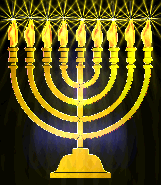"And the sons of Levi; Gershon, Kohath, and Merari" Genesis 46; 11.
LEVI AND SIMEON IN SCANDINAVIA, ITALY, AND AMONGST THE JEWS OF NORTH AFRICA
 Simeon and Levi were brothers, destined to be divided in Jacob, scattered
in Israel (Genesis 49; 7) and therefore were not to be concentrated in one
specific area. The name LEVI seems to recur in family appellations such
as Levison, and Lewis. They were the priestly tribe to which Moses and
Aharon belonged. From Aharon came the Priests or COHANS. Many Levites
fled to Judah before the Ten Tribes were exiled (2-Chronicles 11;13-14).
Likewise a good portion of SIMEON was to be absorbed by Judah both before
the Assyrian Exile and afterwards when the Khazars of Scythia (descendants
of Simeon and Menasseh) re-converted en-masse to Judaism. Talmudic tradition
relates that Simeon was to receive an especial blessing via his affiliation
within the Tribe of Judah. Therefore, what applies to Judah in prophecy
also has significance concerning the Tribe of Simeon.
Simeon and Levi were brothers, destined to be divided in Jacob, scattered
in Israel (Genesis 49; 7) and therefore were not to be concentrated in one
specific area. The name LEVI seems to recur in family appellations such
as Levison, and Lewis. They were the priestly tribe to which Moses and
Aharon belonged. From Aharon came the Priests or COHANS. Many Levites
fled to Judah before the Ten Tribes were exiled (2-Chronicles 11;13-14).
Likewise a good portion of SIMEON was to be absorbed by Judah both before
the Assyrian Exile and afterwards when the Khazars of Scythia (descendants
of Simeon and Menasseh) re-converted en-masse to Judaism. Talmudic tradition
relates that Simeon was to receive an especial blessing via his affiliation
within the Tribe of Judah. Therefore, what applies to Judah in prophecy
also has significance concerning the Tribe of Simeon. The Headobards-Lombards descend from Ohad son of Simeon. They were destined from the area of Scandinavia to migrate southward and ultimately conquer and settle the region of Northern Italy now called LOMBARDY which is famous for its capital of Milano.. LOMBARDY in ancient times had been known as "Gallia Transpadana" and its one-time inhabitants according to Pliny (N.H. 3; 17) had been called "Laevi" or "Levi" (sic.). Thus, the Simeon-Levi association may have been repeated when the Headobards (Ohad from Simeon) settled in the "Levi" neighborhood creating a Lombard-Laevi conjunction.
As stated, the Lombards (Headobards) had emerged from Scandinavia and were closely associated with the Angles who later conquered England. Ptolemy reported a people named "Levonii" in Scandinavia. These too may also have had Levite connections and may have been part of the Lombards, since Ptolemy's report dates to the time when the Lombards were probably still within the Scandinavian area, at least in part. Levi, however, like Simeon, seems to have achieved his natural expression more easily through partnership to Judah to whose kingdom (2-Chronicles 13; 9-11) many Levites fled. Most Levites appear today to be found scattered amongst all sections of the Jewish people and seem to be especially noticeable amongst certain sections of the North African Jewish communities.
LEVI
The Israeli stamp depicts the High Priests breastplate which was worn during the Temple service and as an oracle. It is the symbol of Levi.
ITALY
It was noted that in Lombardy of North Italy settlers from Scandinavia (such as the Headobards sons of Ohad of Simeon) had settled and that a group from Levi had preceded them there. In Lombardy there existed a recurring tendency to "Judaise", meaning to adopt "Old Testament" lores and to imitate forms of worship which were Jewish or at least considered as such . At Milano, capital of Lombardy, for nearly 200 years (1100's-1200's c.e.) there existed a theocratical government using names and ceremonies drawn from the Old Testament. At the same time the sect of Passagii attempted to adopt all of the Mosaic Law as it was understood by them and later from time to time similar tendencies made themselves evident in that country2.
In addition to Israelite, settlement in Lombardy, other Lost Israelites such as the Goths, Vandals, Normans, and so on settled throughout Italy and also bands of Jewish slaves and free Jews had reached Italy in Roman times and many of these assimilated. Even though very many Italians are of Israelite or Jewish origin most are not. They are of mixed origins with a stock related to the Greeks in ascendancy and including a constituent from Edom. Esau the twin-brother of Israel (Jacob) was the forefather of the Edomites and became the arch- enemy of Israel. Descendants of Edom (alongside some Israelites in the past) are in addition numerous amongst the Germans and in the European ruling classes. Even in those nations herein proven to be basically Israelite in many respects, there exist Edomite and Canaanite elements.
TRIBAL IDENTIFICATIONS HOME